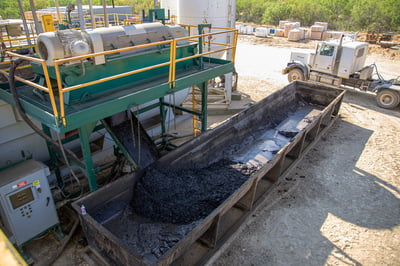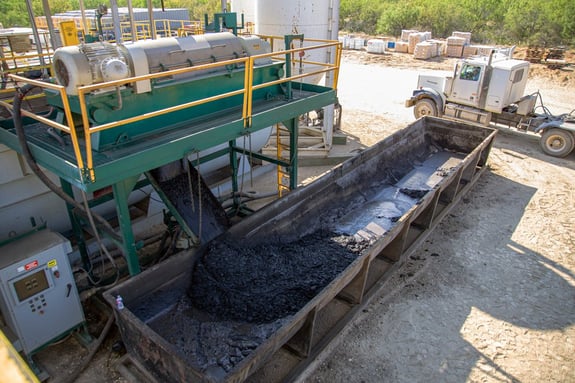 A drilling rig’s solids removal system may be one of the most common, yet undervalued, parts of the drilling system. If the drilling fluid does not transport the cuttings up hole, the drillstring is not making hole and risks becoming stuck. The cuttings must be handled efficiently once they reach the surface. The best drilled well can turn into an environmental headache if the drill cuttings and fluids are not disposed of properly.
A drilling rig’s solids removal system may be one of the most common, yet undervalued, parts of the drilling system. If the drilling fluid does not transport the cuttings up hole, the drillstring is not making hole and risks becoming stuck. The cuttings must be handled efficiently once they reach the surface. The best drilled well can turn into an environmental headache if the drill cuttings and fluids are not disposed of properly.
The solids removal system separates the drill cuttings from the drilling fluid on the surface. The first component of the solids recovery system is the rig shaker, which removes the larger particles of drill cuttings from the slurry returning from the well. Drying or shale shakers further decrease the amount of liquid retained on the drill cuttings. Once this step is performed, drill cuttings are loaded in trucks, removed from the rig site, and disposed of at a permitted disposal site. Efforts should always be made to minimize drilling waste, but proper disposal will always be required.
Drill cuttings disposal methods
Landfarming: This process involves spreading drill cuttings on land and reincorporating them into the soil of a licensed property via tilling, disking, or plowing. The disposal process uses the physical, chemical and biological capabilities of the soil-plant system to control waste migration. This provides a safe means of disposal without impairing the potential of the land for future use.
Injection: Considered environmentally friendly, injection is perhaps the safest and most efficient disposal solution. This zero-discharge disposal option is especially popular in remote areas. In this process, the drill cuttings are ground into fine particles and mixed into a cuttings slurry. The slurry is then re-injected into a well or cavern.
Biodegradation: Biodegradation uses microorganisms to biologically degrade cuttings and mud into simpler components. The process uses a nitrogen source for bacterial growth, continual dilution and an odor suppressant. Currently, biodegradation is considered relatively slow and cannot process large volumes of cuttings.
Solidification: In this process, disposed cuttings and mud are mixed with a solidification agent such as clay, cement, fly ash and/or lime. Mixing cuttings with these substances forms a concrete-like solid, which mechanically binds the cuttings. The solid product can be disposed of at an authorized disposal site or repurposed for road aggregate, engineered fill or construction material.
Incineration: In this process, thermal systems are used to burn drill cuttings, typically in offshore drilling settings. Due to the resulting air emissions, safety concerns of the heat source, and high efficiency required, this is not a widely used disposal method.
Regulatory guideline considerations
Understanding and adhering to local and state disposal regulations is another critical component of the haul-off and disposal process. Regulatory requirements can be difficult to maneuver. However, improper disposal can cause environmental harm, risk ground and water contamination and result in operator fines.
Common state regulatory parameters for haul-off and disposal include secondary containment requirements for tanks, and requirements for placing solid waste management facilities away from critical infrastructure or inhabited development. Complicated disposal permitting processes in one state may drive some operators to dispose of drill cuttings in an adjoining state where regulations and permitting are more favorable.
Best practices for drilling waste management
A sound solids control system effectively and efficiently separates the drill cuttings from the drilling fluid and is an integral part of a drilling fluid management system. The total fluids management approach has many benefits that result in full system efficiencies:
- Reduces the amount of solids content in the mud
- Reduce costs of drilling fluid maintenance, clean-up, and disposal
- Help achieve environmental and regulatory compliance
- Allows higher flow rates
- Extends the life of the drilling fluid
The following steps can help optimize drilling waste management:
- Select the best route from the rig site to the disposal site. Consider the condition of the road, the length of travel, and whether the route traverses any highly populated areas.
- Ensure that trucks are fully enclosed and sealed when transporting cuttings.
- Use a trucking company that is fully vetted and licensed, employs experienced, qualified drivers and uses equipment that has undergone safety and maintenance checks.
- Make sure that trucks are on hand and ready to go as drilling waste accumulates.
- Design the wellsite so the equipment footprint allows for safe truck entry, loading and exiting.
- Consider using a closed-loop system for efficient and environmentally-safe operations.
The Panther advantage
Panther Fluids can safely and efficiently dispose of drill cuttings and fluids throughout the drilling process. From removing cuttings to maintaining the right drilling fluid mix to safely transporting the cuttings to the disposal site, Panther has the experience to do the job right. Our total fluids management approach means we can take care of all fluids-related activities including the mud system, chemicals and additives, solids control and closed-loop systems and haul off and disposal. Panther takes care of the details so you can focus on drilling the well.

